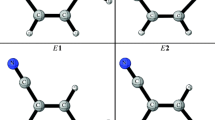Abstract
DFT/B3LYP/6-311G(d) and CCSD(T)/6-311G(2d) single-point calculations are carried out for exploring the doublet potential energy surface (PES) of PC3O, a molecule of potential interest in interstellar chemistry. A total of 29 minima connected by 65 interconversion transition states are located. The structures of the most relevant isomers and transition states are further optimized at the QCISD level followed by CCSD(T) single-point energy calculations. At the CCSD(T)/6-311G(2df)//QCISD/6-311G(d)+ZPVE level, the global minimum is the quasi-linear structure PCCCO 1 (0.0 kcal/mol) with a great kinetic stability of 47.9 kcal/mol, and the cumulenic form \({\mathop P\limits_ - ^ \bullet}=C=C=C={\mathop O\limits_ - ^ -}\) features largely in its resonance structures. Moreover, the chainlike isomer OPCCC 3 (64.5) and five-membered-ring species cPCCCO 19 (77.8) possess considerable kinetic stability of about 18.0 kcal/mol. All these three isomers are very promising candidates for future experimental and astrophysical detection. Additionally, a three-membered-ring isomer CC-cCOP 10 (69.6) has slightly lower kinetic stability of around 15 kcal/mol and may also be experimentally observable. Possible formation mechanisms of the four stable isomers in interstellar space are discussed. The present research is the first attempt to study the isomerization and dissociation mechanisms of PC n O series. The predicted spectroscopic properties, including harmonic vibrational frequencies, dipole moments and rotational constants for the relevant isomers, are expected to be informative for the identification of PC3O in laboratory and interstellar medium.
Similar content being viewed by others
References
Kaiser RI (2002). Chem Rev 102:1309
Winnewisser G, Kramer C (1999). Space Sci Rev 90:181
Largo A, Barrientos C, Lopez X, Ugalde JM (1994). J Phys Chem 98:3985
del Rio E, Barrientos C, Largo A (1996). J Phys Chem 100:585
Zhan CG, Iwata S (1997). J Chem Phys 107:7323
Pascoli G, Lavendy H (1999). J Phys Chem A 103:3518
Li GL, Tang ZC (2003). J Phys Chem A 107:5317
Millar TJ (1991). Astron Astrophys 242:241
Sumiyoshi Y, Takada H, Endo Y (2004). Chem Phys Lett 387:116
McCarthy MC, Cooksy AL, Mohamed S, Gordon VD, Thaddeus P (2003). Astrophys J Suppl Ser 144:287
Yu GT, Ding YH, Huang XR, Chen GH, Tang AC (2004). J Phys Chem A 108:10723
Nakajima M, Yoneda Y, Sumiyoshi Y, Endo Y (2004). J Chem Phys 120:2662
Pedersen CT, Fanghanel E, Flammang R (2001). J Chem Soc Perkin Trans 2:356
Frisch MJ, Trucks GW, Schlegel HB, Scuseria GE, Robb MA, Cheeseman JR, Zakrzewski VG, Montgomery JA Jr, Stratmann RE, Burant JC, Dapprich S, Millam JM, Daniels AD, Kudin KN, Strain MC, Farkas O, Tomasi J, Barone V, Cossi M, Cammi R, Mennucci B, Pomelli C, Adamo C, Clifford S, Ochterski J, Petersson GA, Ayala PY, Cui Q, Morokuma K, Malick DK, Rabuck AD, Raghavachari K, Foresman JB, Cioslowski J, Ortiz JV, Stefanov BB, Liu G, Liashenko A, Piskorz P, Komaromi I, Gomperts R, Martin RL, Fox DJ, Keith T, Al-Laham MA, Peng CY, Nanayakkara A, Gonzalez C, Challacombe M, Gill PMW, Johnson BG, Chen W, Wong MW, Andres JL, Head-Gordon M, Replogle ES, Pople JA (1998) Gaussian 98, revision A.9. Gaussian, Inc., Pittsburgh
Karlström G, Lindh R, Malmqvist P-Å, Roos BO, Ryde U, Veryazov V, Widmark P-O, Cossi M, Schimmelpfennig B, Neogrady P, Seijo L (2003). Comput Mater Sci 28:222
Reed AE, Weinstock RB, Weinhold F (1985). J Chem Phys 83:735
Yu GT, Ding YH, Huang XR, Sun CC (2005). J Phys Chem A 109:1594
Ding YH, Liu JL, Huang XR, Li ZS, Sun CC (2001). J Chem Phys 114:5170
Author information
Authors and Affiliations
Corresponding author
Rights and permissions
About this article
Cite this article
Liu, Y., Huang, XR., Yu, GT. et al. Structure and Stability of Isomers of the Promising Interstellar Molecule PC3O. Theor Chem Acc 115, 410–426 (2006). https://doi.org/10.1007/s00214-006-0122-4
Received:
Accepted:
Published:
Issue Date:
DOI: https://doi.org/10.1007/s00214-006-0122-4




